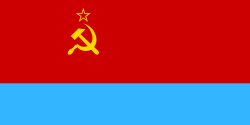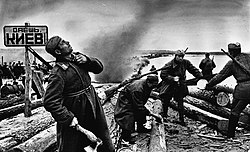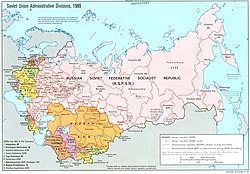Ukrainian Soviet Socialist Republic
The Ukrainian Soviet Socialist Republic or in short, the Ukrainian SSR or Soviet Ukraine was in the southwestern part of the Soviet Union. It had the second largest population of the fifteen constituent republics of the Soviet Union. This lasted from 1922 to 1991.
Ukrainian Soviet Socialist Republic (1936–1991)
Ukrainian Socialist Soviet Republic (1919–1936)
| |
|---|---|
| 1919–1991 1941–1944: German and Romanian occupation | |
| Motto: | |
| Anthem: | |
 Location of the Ukrainian SSR within the Soviet Union from 1954 | |
| Status | Independent Socialist Republic (1919–1922) Union Republic of the USSR (1922–1990) Union Republic with priority of Ukrainian legislation (1990–1991) |
| Capital | Kharkiv (1919–1934)[1] Kyiv (1934–1991)[2] |
| Common languages | Russian (dominant)[3][4] Ukrainian (folkloristic)[4] (in 1990 Ukrainian declared as official)a[5] |
| Government | Soviet republic |
| First Secretary | |
• 1918–1919 | Emanuel Kviring (first) |
• 1990–1991 | Stanislav Hurenko (last) |
| Head of state | |
• 1919–1938 | Grigory Petrovsky (first) |
• 1990–1991 | Leonid Kravchuk (last) |
| Head of government | |
• 1919–1923 | Christian Rakovsky (first) |
• 1988–1991 | Vitold Fokin (last) |
| Legislature | Supreme Soviet[6] |
| Historical era | 20th century |
• Declaration of the Ukrainian Soviet republic | 10 March 1919 |
• | 30 December 1922 |
| 15 November 1939 | |
| 24 October 1945 | |
• Priority of Ukrainian laws declared, Soviet laws partially abolished | 16 July 1990 |
• Declaration of independence, Ukrainian SSR renamed to Ukraine | 24 August 1991 |
| 1 December 1991 | |
| 10 December 1991 | |
• | 26 December 1991 |
• Soviet government officially abolished (New constitution) | 28 June 1996 |
| Area | |
| 1989 census | 603,700 km2 (233,100 sq mi) |
| Population | |
| 51,706,746 | |
| Currency | Soviet ruble (karbovanets) |
| Calling code | 7 03/04/05/06 |
| Today part of | |
| |
The Ukrainian SSR was a founding member of the United Nations.[7] It did not really have much power because it was tightly controlled by central all-Soviet Union authorities. When the Soviet Union broke apart, the Ukrainian SSR became Ukraine.
During its 72-year history, the republic's borders changed many times. The eastern city of Kharkiv was the republic's first capital. However, in 1934, it was moved to the city of Kyiv. Kyiv is still the capital of Ukraine. Among other largest cities there were Odesa, Dnipro, Donetsk (named Stalino before 1961), Lviv, Zaporizhia.
History
Ukrainian SSR was one of 4 first republics of USSR.
In 1939 some lands of Western Ukraine was incorporated in Ukrainian SSR. It was occupied by Poland in 1921 and had cities Lviv, Ternopil, Stanislav (now Ivano-Frankivsk), Rivne.
In 1940 was taken from Romania Nortern Bukovina (Chernivtsy oblast) and part of Bessarabia.
During the WWIV all of its territory was occupied. There was large partisan movements. Kyiv and Odesa became hero cities.
In 1953 former head of Communist party of Ukraine Nikita Khrushchev became the General Secretary of the CPSU. In 1964 he was removed by Ukrainian Leonid Brezhnev who was in office before his death in 1982.
In 1954 Crimea was incorporated in Ukrainian SSR.
In 1986 there was Chernobyl atomic station catastrophe.
Demographic
In the republic there were about 29 mln people in 1926, 47.1 mln in 1970, 49.6 mln in 1979, 51.7 mln in 1989.
In 1989 5 cities had more than 1 million people. It was Kyiv (2.6 mln), Kharkiv (1.6 mln), Dnipro (1.2 mln), Odesa (1.1 mln) and Donetsk (1.1 mln).
The larger nation was Ukrainians, 2nd nation was Russians during all the history. Among the other nations were Jews, Belarusians, Moldovans and Romanians, Poles, Greeks.
Ukrainian Soviet Socialist Republic Media
Anthem of the Ukrainian Soviet Socialist Republic (Instrumental)
Soviet soldiers preparing rafts to cross the Dnieper during the Battle of the Dnieper (1943). The sign in Russian reads: "Let's get Kiev!"
The Curzon Line expanded the territory of the Ukrainian SSR to include western Ukraine, previously controlled by Poland.
Soviet postal stamp, 1954, in honour of the 300th anniversary of Ukraine re-unification with Russia (Soviet name for the Pereiaslav Agreement), Russian: 300-летие Воссоединения Украины с Россией).
Three Soviet general secretaries were either born or raised in Ukraine: Nikita Khrushchev and Leonid Brezhnev (depicted here together), and Konstantin Chernenko.
Location of the Ukrainian SSR (yellow) within the Soviet Union in 1954–1991
The 1991 Ukrainian presidential election. Former dissident Viacheslav Chornovil gained 23.3 percent of the vote, compared to 61.6 percent for then Acting President Leonid Kravchuk.
The Declaration of Independence, as printed on the ballot for the referendum on 1 December 1991
References
- ↑ "History" (in Ukrainian). Kharkiv Oblast Government Administration. Retrieved 16 April 2011.
{{cite web}}: CS1 maint: unrecognized language (link) - ↑ Soviet Encyclopedia of the History of Ukraine (in Ukrainian). Academy of Sciences of the Ukrainian SSR. 1969–1972.
{{cite book}}: CS1 maint: unrecognized language (link) - ↑ Language Policy in the Soviet Union by Lenore Grenoble, Springer Science+Business Media, 2003, ISBN 978-1-4020-1298-3.
- ↑ 4.0 4.1 Mariya Kapinos. Honest History: Where, why Ukrainians speak Russian language (and how Kremlin uses it to stoke conflict in Ukraine). Kyiv Post. 6 April 2018
- ↑ Law of Ukraine "About languages of the Ukrainian SSR"
- ↑ History of Ukraine: The Land and Its Peoples by Paul Robert Magocsi, University of Toronto Press, 2010, ISBN 1442640855
- ↑ "Activities of the Member States - Ukraine". United Nations. Retrieved 2011-01-17.








